 |
|
Here and There introduces art, artists, galleries, museums, and other cultural facilities around Japan that non-Japanese readers and first-time visitors may find of particular interest.
|
|
 |
|
|
 |
 |
Giving Art a Listen at Arts Maebashi
Alan Gleason |
 |
Aki Onda, "Collage on Cassettes" (2018) |
Listening takes time. It also requires a place with minimal distractions. Looking -- at a painting, for example -- can, on the other hand, transmit a vast amount of information instantaneously. When we go to an art museum with, say, only a couple of hours to view several dozen works, we move quickly from painting to painting, often allowing ourselves only a few seconds to decide which ones merit a longer look.
A museum therefore may not be the ideal environment for a show as listening-centered as this one is. That said, Arts Maebashi has demonstrated admirable courage in trying to pull it off at all. Listening: Resonant Worlds (up until 21 March) offers a frustrating but ultimately worthwhile experience -- frustrating because it consists entirely of multimedia installations that, if viewed and heard in full, would take a day to absorb; worthwhile because the content is both challenging and affecting.
Some prepping is in order before you go. I came to the show knowing almost nothing about it except that it featured works utilizing sound. What I imagined was one of those multimedia presentations that resemble light shows with sound effects. Listening is not like that at all. Sound is indeed the pivotal medium of every installation here, but in ways that are not hands-on or particularly immersive. Nearly all, however, have to be experienced while wearing a headset -- provided at the entrance, though viewers are encouraged to bring their own smartphone and earphones to access the soundtracks via WiFi. One problem with this technical consideration is that the on-site instructions are sparse and mostly in Japanese, so I recommend that English-speaking visitors peruse the exhibition's very thorough English-language website in advance. Otherwise you will find yourself befuddled by the profusion of video screens and headphone outlets in a sequential layout that sometimes makes it hard to tell where one installation ends and the next begins.
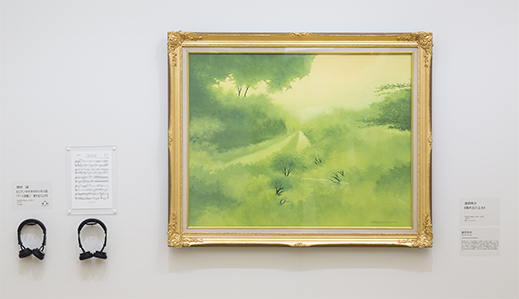 |
|
Makoto Nomura, Arts Maebashi: 9 Short Pieces for Piano 1, Tamagawa Waterworks in Spring (2013); painting by Kakuji Kurata, oil on canvas (1995) |
The first installation, by contemporary composer Makoto Nomura, is the only one that matches music to works of art, a tried-and-true multisensory format that works very well here. Indeed, one suspects it may have been the original impetus for this show. Four oil paintings by Maebashi-area artists are to be viewed while listening to short compositions inspired by each work, part of a series, 9 pieces for piano "Arts Maebashi", that Nomura developed from a 2013 workshop at the museum when it first opened. According to the website: "[E]ach participant brought an instrument and played it looking at a painting from the museum's collection as if it were a sheet of music." Nomura then notated those impromptu melodies for piano and recorded them. The pieces are sprightly and stimulating, and their scores are displayed next to each painting. One wishes there were more of them.
Rounding the corner past the Nomura installation brings you face-to-face with a bank of video screens simultaneously projecting linked documentaries by the artist duo Haruka Komori and Natsumi Seo. Their theme is the lives of residents of Rikuzentakata, a city in northern Japan that was virtually destroyed by the tsunami of March 2011. Komori and Seo first visited it as volunteers in the immediate aftermath of the disaster and began interviewing people who had lost their homes and families. They then returned several years later to meet the same people and record the drastic changes made to their neighborhoods as part of the reconstruction process. The narratives are leisurely paced and often without dialogue, which makes it difficult to get fully engaged with them in the gallery. However, the website carries Vimeos of all the works in full (caveat: no English subtitles), and they prove to be poignant, beautiful, and heartbreaking.
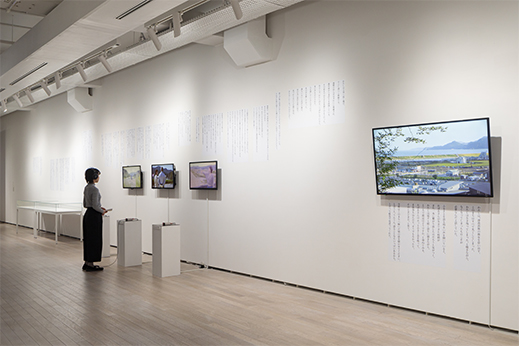 |
|
Installation view, Haruka Komori + Natsumi Seo, In the Eye of Migratory Birds (2020); text, leaflet, video, memoirs (Hiromi Abe, Yuichiro Izutsu, Fumihiro Ono, Tokuko Sato, Yukiko Terui and others) |
Probably the show's most ambitious installation is the one in the next gallery, a full-fledged sound work by the Taiwanese artist Wang Hong-Kai. Titled Borom, it chronicles, mostly though audio recordings, the flight of the Korean poet Kim Sijong from his native island of Jeju (off the southern coast of Korea) to Japan in the wake of the April 3 Uprising, a 1948 rebellion that ended with the South Korean government's massacre of thousands of islanders. Wang traces Kim's journey as he moved from one hiding place to another on the island before finally swimming at night to a rocky islet some 30 kilometers offshore and surviving there for several days before he was picked up by a boat of refugees heading for Japan, where he has lived and worked ever since.
Visually, the installation is dominated by a large map of Jeju and the surrounding sea. Shown here are wind and ocean currents, as well as a geologic map of the basalt rock formations that cover the volcanic island. But the centerpiece is a series of 20 ambient recordings made at places where Kim hid during his flight. Titles (provided in English) offer some context ("Suwolbong [Lava strata, Typhoon]"), but the prevailing sound is that of the wind -- a constant presence on Jeju (borom means "wind" in the local dialect) -- along with the crashing of waves on rocky shores and the cries of seabirds. These are haunting tracks but, as each is several minutes long, without some background information they are not easy to process.
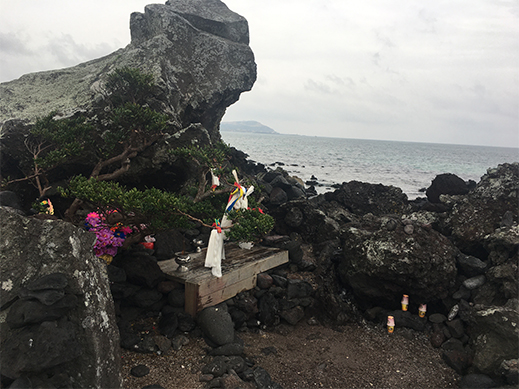 |
|
Wang Hong-Kai, Borom / Jeju Island, South Korea (2020); photo by Kyung-Duck Kang |
On a dais in a corner is a stack of copies of "Booklet/playbill for Borom," a nicely designed publication in Japanese, English, and Korean. Free for the taking, it provides all the background one could ask for. Again, it's the sort of thing best read beforehand, not while at the show. Oddly, the big map of Jeju on the wall doesn't mark the locations of the 20 recordings, yet a similar map on the website does. You can also hear all of the soundtracks in their entirety online.
Rounding yet another corner, one enters a large gallery devoted to an audiovisual work by Aki Onda, an artist known for his extensive field recordings on cassette. Silence Prevails: East Village Community Gardens During the Pandemic features recordings he made last year in two dozen of the remarkable resident-tended gardens that dot New York's Lower East Side. Video screens predominate here as in the installation by Komori+Seo, augmented by still images and maps. The views of the gardens are lovely, but the soundscapes of people chatting, birds chirping, and traffic rumbling in the background, however evocative, do not provide a viewer-on-the-move with much to grab onto. As elsewhere, the website offers the most rewarding in-depth experience via a 13-minute Vimeo digest of footage from several of the gardens. Like Borom, Silence Prevails does come with a thorough English-language guide (eloquently translated by Artscape contributor Colin Smith) in the form of a large map with keyed descriptions of the artist's impressions of each garden. An extra visual treat is a big display of close-ups of Onda's colorfully decorated collection of tape cassettes. It's a relief, actually, to have some eye candy that stands still after the parade of videos and soundtracks.
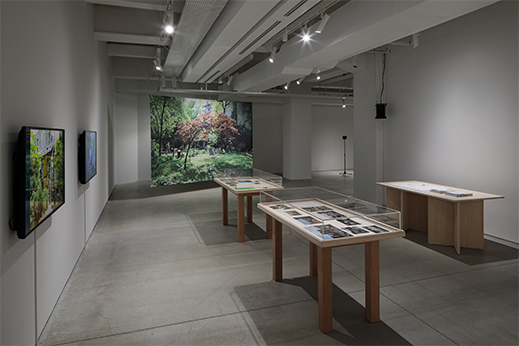 |
|
Installation view, Aki Onda, Silence Prevails: East Village Community Gardens During the Pandemic (2020); field recordings, videos, archival pigment prints, dye-sublimation print, texts, map |
Perhaps the most satisfying video presentation is that of Australia-based Angelica Mesiti. Projected on two big screens in a dark theater, Mother Tongue juxtaposes footage of people of varying cultural backgrounds singing, dancing, and playing instruments in the Danish city of Aarhus. Though not overtly contrastive, a distinction emerges between the sedate choruses of Danes in school or at church and the more vigorous performances -- ranging from dance routines in a park to a band practicing in an apartment living room -- by immigrants from Africa and the Middle East. Amid these set pieces is an enigmatic sequence of a young dancer of unspecified ethnicity doing quiet, almost contemplative handstands atop desks in the august chambers of the Aarhus city council.
Installation view, Angelica Mesiti, Mother Tongue (2017); two-channel high definition color video installation and surround sound, 17 minutes 54 seconds |
There is a strong current of social commentary running through most of these works, a sensibility that also informs a number of documentaries screened concurrently at the neighboring Maebashi Cinema House. Unfortunately the screenings are few and far between, the last one being scheduled for 20 March. Two standouts that I hope to see someday are Kaori Sakagami's Prison Circle (2019), a look at the first prison in Japan to institute a talk-therapy program for inmates, and Kazuhiro Soda's Zero, about a retired psychotherapist dealing with his wife's advancing dementia. The trailers (viewable on the website) for these films alone are gut-wrenching and tear-inducing.
Still image from Haruka Komori + Natsumi Seo, Double layered town / Making a song to replace our positions (2017) |
The museum itself was a pleasant surprise for this first-time visitor. Located in Maebashi, the administrative seat of Gunma Prefecture and an hour-and-a-half train ride northwest of Tokyo, it occupies a quiet downtown street corner a few minutes' walk from the station. A city-funded project, the museum opened only seven years ago in a radically refurbished former department store. The old escalator well has been transformed into an atrium linking the two exhibit floors, and the façade is wrapped in a sheet of white perforated aluminum that stakes the renovated building as a new face on the block. Signage throughout the museum sports an eye-grabbing contemporary font with letters made from black tubing that passes through perforations in aluminum backing that echoes the exterior shell. Everything is painted white, and the effect is of a bright, welcoming, and very contemporary urban space.
|
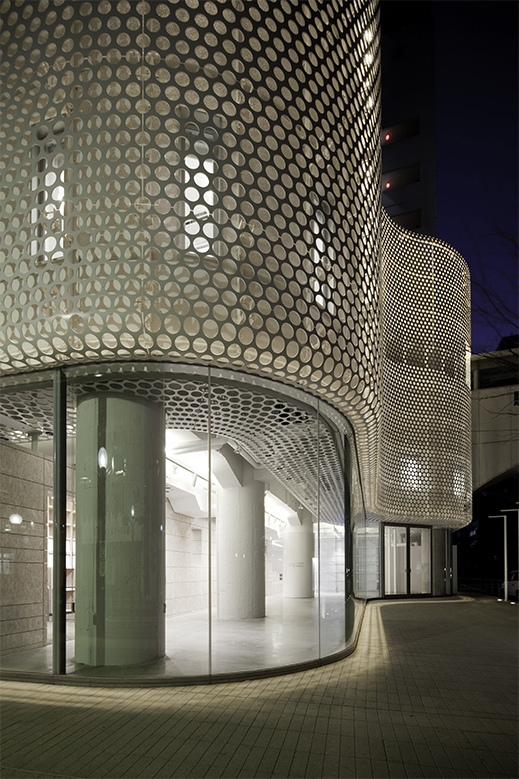 |
|
|
|
The façade of Arts Maebashi. Photo by Shinya Kigure
|
The galleries on the main exhibit floor, in the basement, are concentrically laid out with a split-level windowed promenade sandwiched between a central gallery and the outer ring of contiguous, unpartitioned spaces occupied by the Listening exhibition. It's an attractive design, if not quite ideal for this show, for the simple reason that the sounds emanating from each installation tend to leak into the adjoining galleries. In any case a visitor's experience will be richly enhanced by first checking out the Listening website, with its wealth of audio and video clips from every installation. The online presentation is also a godsend for anyone who can't make it to Maebashi, or who hesitates to visit a museum while the pandemic still rages.
All images courtesy of Arts Maebashi. |
 |
| Listening: Resonant Worlds |
| 12 December 2020 - 21 March 2021 |
| Arts Maebashi |
5-1-16 Chiyodamachi, Maebashi, Gunma
Phone: 027-230-1144
Hours: 10 a.m. to 6:00 p.m. (entry until 5:30 p.m.); closed Wednesdays
Access: 10 minutes' walk from Maebashi Station on the JR Ryomo Line; about 1 1/2 hours from Tokyo via Shinkansen (transfer to Ryomo Line at Takasaki)
|
|
|
|
| |
 |
Alan Gleason
Alan Gleason is a translator, editor and writer based in Tokyo, where he has lived for over 30 years. Since 2006 he has edited artscape Japan and written the Here and There column, as well as translating the Picks reviews. He also edits and translates works on Japanese architecture, music, and theater. |
|
|
|
|
|
|
|
|
|
 |
|